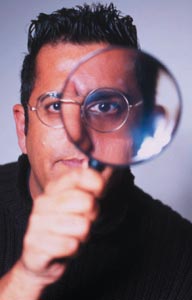Simon Singh believes that the best way for scientists to interest the public may be to forget the unknown and amaze them with what they know.
Naturally, researchers take for granted that which is known, and instead focus on the unknown. Indeed, when I was at CERN working on the UA2 experiment, everyone was obsessed wih those areas of physics that were not yet understood. The public is also interested in those scientific subjects that still remain a mystery – where is the Higgs boson? Is string theory correct? What is dark matter? So when I left particle physics and became a science journalist, I continued to concentrate on unexplored territory. It was those research topics at the frontiers of knowledge and at the centre of controversy that inevitably resulted in the best stories.

However, when I sat down to write Big Bang, I decided to adopt a different approach – I wanted to celebrate how much we do know, and glory in the fact that we belong to the first generation of humans that have access to a coherent, consistent, compelling and verifiable model of the universe. The public is told so much about contentious issues, such as arguments over the existence, type and quantity of dark matter, that they probably have the impression that cosmologists know very little about the universe. In fact, I think the public would be staggered if they realized how much we do know.
The fact that the universe is expanding might seem dull to those of us within science, but to outsiders it probably sounds incredible. I suspect that the majority of the public perceive the expansion of the universe as a weird new hypothesis that will be overturned in a few years. If only they realized that the expansion of the universe was detected more than 75 years ago and has since been measured in detail and verified in a multitude of ways, then they might begin to engage with the staggering and profound implications of an expanding cosmos.
As well as spreading the gospel of our understanding of the universe, including the Big Bang model, I also wanted to show how superior models emerge in science and how they are eventually accepted, regardless of how controversial they are initially and no matter how powerful their detractors might be. Although we should be celebrating Albert Einstein in the centenary of his annus mirabilis, it is still worth noting that he vehemently opposed the Big Bang model when it was explained to him by the Belgian cosmologist (and priest) Georges Lemaître. Einstein told him, “Your calculations are correct, but your physics is abominable.” But a few years later, the observations showed that Lemaître was right, and Einstein had to concede defeat in the light of reality. The Big Bang model turned out to be basically correct and remains the best game in town.
Despite all the successes of modern cosmology and the Big Bang model, my book does feature an epilogue that explains the ways in which the model is incomplete. There are, of course, still aspects of our universe that cause bewilderment and arguments among cosmologists. For example, was there an inflationary period in the early universe, what is dark matter, what is dark energy and what is the fate of the universe? Such questions currently belong to the realm of speculation, and answering them sometimes seems impossible.
However, perhaps my book offers a note of optimism for cosmologists, because they can take heart by looking back through the history of their subject. After all, what now seems completely obvious was itself mysterious to scientists of the past. There was a time when nobody had any idea of how to measure the distances to the nebulae, but in 1923 Edwin Hubble solved the puzzle and showed that many of them were remote galaxies. He relied on the periodic variation in brightness of a type of star, known as a Cepheid variable, which he spotted in the Andromeda Nebula. The time between peaks in brightness betrays the absolute brightness of a Cepheid star and this could be compared to its apparent brightness in order to deduce its distance – and the distance to the Andromeda Nebula that it inhabited. Today, measuring the distances to galaxies is still not routine, but it is clearly no longer impossible.
Perhaps the best example of a once impossible problem that soon became trivial was discussed in 1835 by the French philosopher Auguste Comte. He had tried to identify areas of knowledge that would forever remain beyond the wit of scientific endeavour. In particular, he thought that some qualities of the stars could never be ascertained. “We see how we may determine their forms, their distances, their bulk, and their motions, but we can never know anything of their chemical or mineralogical structure.” In fact, Comte would be proved wrong within a few years of his death, as scientists began to discover which types of atom exist in the Sun.








